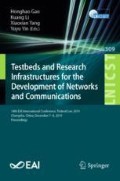Abstract
Mysterious and uncertain deaths in the “Game of Thrones” novel-series have been stupefying to the vast pool of readers and hence interested researchers to come up with various models to predict the deaths. In this paper, we propose a Death-Prone Score model to predict if the candidate character is going to die or stay alive in the upcoming book in the series. We address the challenge of high-dimensional data and train our model on the most significant attributes by computing feature importance in the vector space. Further, we address the challenge of multiple interactions between characters and create a social network representing the weighted similarity between each character pair in the book. The proposed model takes similarity and proximity in a social network into account and generates a death-prone score for each character. To evaluate our model, we divide the characters data into training (characters died before year 300) and testing (characters died in the year 300 and characters alive till year 300). Our results show that the proposed Death-Prone Score model achieves an f-score of 86.2%.
Access this chapter
Tax calculation will be finalised at checkout
Purchases are for personal use only
Notes
- 1.
- 2.
- 3.
- 4.
- 5.
- 6.
References
Athey, S., Tibshirani, J., Wager, S., et al.: Generalized random forests. Ann. Stat. 47(2), 1148–1178 (2019)
Beveridge, A., Shan, J.: Network of thrones. Math Horiz. 23(4), 18–22 (2016)
Boldi, P., Santini, M., Vigna, S.: PageRank as a function of the damping factor. In: Proceedings of the 14th International Conference on World Wide Web, pp. 557–566. ACM, New York (2005)
Bonato, A., D’Angelo, D.R., Elenberg, E.R., Gleich, D.F., Hou, Y.: Mining and modeling character networks. In: Bonato, A., Graham, F.C., Prałat, P. (eds.) WAW 2016. LNCS, vol. 10088, pp. 100–114. Springer, Cham (2016). https://doi.org/10.1007/978-3-319-49787-7_9
Chakrabarti, S.: Dynamic personalized pagerank in entity-relation graphs. In: Proceedings of the 16th International Conference on WWW, pp. 571–580 (2007)
Farine, D.R.: When to choose dynamic vs. static social network analysis. J. Anim. Ecol. 87(1), 128–138 (2018)
Geurts, P., Ernst, D., Wehenkel, L.: Extremely randomized trees. Mach. Learn. 63(1), 3–42 (2006)
Haghani, S., Keyvanpour, M.R.: A systemic analysis of link prediction in social network. Artif. Intell. Rev. 52(3), 1961–1995 (2019)
Ibnoulouafi, A., Haziti, M.E., Cherifi, H.: M-centrality: identifying key nodes based on global position and local degree variation. J. Stat. Mech.: Theory Exp. 2018(7), 073407 (2018). http://stacks.iop.org/1742-5468/2018/i=7/a=073407
Janosov, M.: Network science predicts who dies next in game of thrones. Department of Network and Data Science Group at Central European University (2017). https://networkdatascience.ceu.edu/article/2017-07-08/network-science-predicts-who-dies-next-game-thrones
Jia, R., Liang, P.: A game of thrones: power structure and the stability of regimes. In: Wärneryd, K. (ed.) The Economics of Conflict: Theory and Empirical Evidence. CESifo Seminar Series, pp. 79–104. MIT Press, Cambridge (2014)
Lakiotaki, K., Delias, P., Sakkalis, V., Matsatsinis, N.F.: User profiling based on multi-criteria analysis: the role of utility functions. Oper. Res. Int. J. 9(1), 3–16 (2009)
Liben-Nowell, D., Kleinberg, J.: The link-prediction problem for social networks. J. Am. Soc. Inf. Sci. Technol. 58(7), 1019–1031 (2007)
Maurella, C., et al.: Social network analysis and risk assessment: an example of introducing an exotic animal disease in Italy. Microb. Risk Anal. 13 (2019). https://doi.org/10.1016/j.mran.2019.04.001. ISSN: 2352-3522
Moradabadi, B., Meybodi, M.R.: Link prediction in weighted social networks using learning automata. Eng. Appl. Artif. Intell. 70, 16–24 (2018)
Pierce, E., Kahle, B., Downey, A.: Bayesian survival analysis for “game of thrones”. A blog by Allen Downey (2015). http://allendowney.blogspot.com/2015/03/bayesian-survival-analysis-for-game-of.html
Sah, P., Mann, J., Bansal, S.: Disease implications of animal social network structure: a synthesis across social systems. J. Anim. Ecol. 87(3), 546–558 (2018)
Schubart, R., Gjelsvik, A.: Women of Ice and Fire: Gender, Game of Thrones and Multiple Media Engagements. Bloomsbury, New York (2016)
Shurkin, J.: Using social networks to analyze the classics. Inside Science (2012). https://www.insidescience.org/news/using-social-networks-analyze-classics
Tracy, P.: Using big data to accurately predict death in the ‘game of thrones’ series. Intelligence on all things wireless, RCR Wireless News (2016). https://www.rcrwireless.com/20160915/big-data-analytics/game-of-thrones-tag31-tag99
Tschiatschek, S., Singla, A., Gomez Rodriguez, M., Merchant, A., Krause, A.: Fake news detection in social networks via crowd signals. In: Companion Proceedings of the The Web Conference 2018, pp. 517–524. International World Wide Web Conferences Steering Committee (2018)
Zhang, Y., Mu, L., Shen, G., Yu, Y., Han, C.: Fault diagnosis strategy of CNC machine tools based on cascading failure. J. Intell. Manuf. 30(5), 2193–2202 (2019)
Author information
Authors and Affiliations
Corresponding author
Editor information
Editors and Affiliations
Rights and permissions
Copyright information
© 2020 ICST Institute for Computer Sciences, Social Informatics and Telecommunications Engineering
About this paper
Cite this paper
Agarwal, S., Thakur, R., Mishra, S. (2020). A Link Analysis Based Approach to Predict Character Death in Game of Thrones. In: Gao, H., Li, K., Yang, X., Yin, Y. (eds) Testbeds and Research Infrastructures for the Development of Networks and Communications. TridentCom 2019. Lecture Notes of the Institute for Computer Sciences, Social Informatics and Telecommunications Engineering, vol 309. Springer, Cham. https://doi.org/10.1007/978-3-030-43215-7_16
Download citation
DOI: https://doi.org/10.1007/978-3-030-43215-7_16
Published:
Publisher Name: Springer, Cham
Print ISBN: 978-3-030-43214-0
Online ISBN: 978-3-030-43215-7
eBook Packages: Computer ScienceComputer Science (R0)

